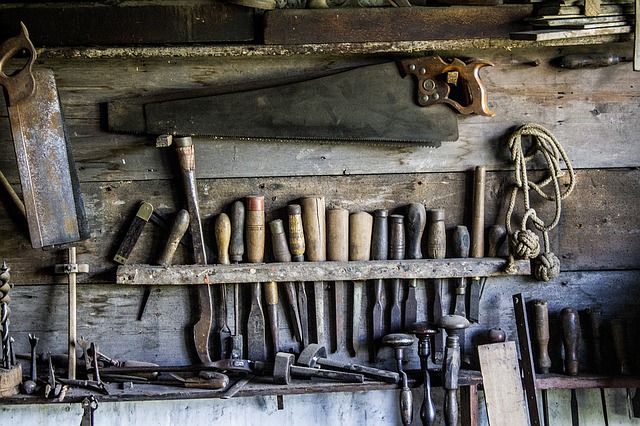There are a lot of tools that are used when you first start out in woodworking or any type of carpentry. The good news is that if you don’t have many tools, you really don’t need to worry about buying everything you will ever need (or want) straight away. Just buy a few basics with a focus on what you will need for the project you want to tackle. The rest can get added over time.
We have assembled a list of the must have top 30 tools used by carpenters with their names to help you out. Remember that as you become a more experienced woodworker or carpenter, your knowledge of tools will grow. You will make better decisions when purchasing new tools as you’ll have knowledge and experience to help you out.
What tools do Carpenters Use?
- Pencil
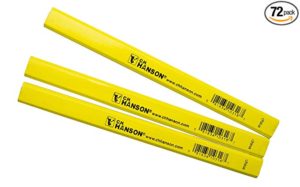
It may seem obvious, but a pencil really is the most important tool for a carpenter. There are even mechanical carpenter’s pencil that don’t really need sharpening (looks a bit like a utility knife to make a sharp, clear line). It’s a little pricey but super easy to carry and use. Regardless, a pencil is the carpenter’s best buddy with a wide variety of uses and used frequently.
- Tape Measure
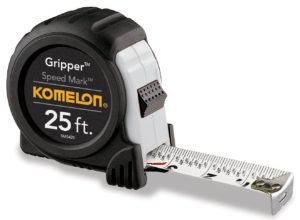 Tape measures are so important. One of my favourite expressions is, ‘Measure twice, cut once’. No truer words were spoken. It was used by Ross Perot during his campaign for president in 1992. Like the pencil, the trusty tape measure is an essential tool that are worth their weight in gold. There are multiple options available, including electronic ones.
Tape measures are so important. One of my favourite expressions is, ‘Measure twice, cut once’. No truer words were spoken. It was used by Ross Perot during his campaign for president in 1992. Like the pencil, the trusty tape measure is an essential tool that are worth their weight in gold. There are multiple options available, including electronic ones.
Pro Tip: be sure to have one with the option of meters and feet as sometimes both systems are used in the plans and on the job.
- Utility Knife
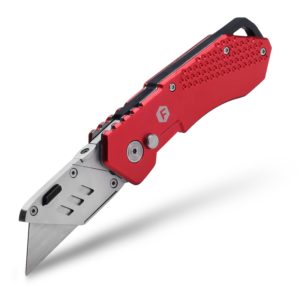
Without question a utility knife is a must have in any workshop. They are super handy for cutting and cleaning joints. The most common utility knives have disposable blades that can slide inside the tool for easy storage.
- Tool Belt:
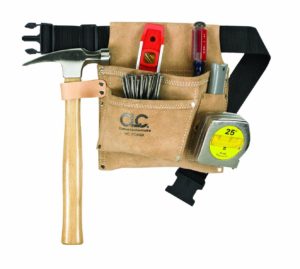
A tool belt is a well arranged kit containing all your necessary tools allowing you to work efficiently with the convenience of mobility around jobsites and ladders safely. While I guess they’re not absolutely essential for basic DIY, they do come in handy when you’re regularly using claw hammers, chalk, pencils/pens, putty and utility knives and Linemans pliers.
- Screwdriver
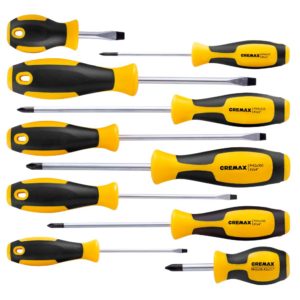
Screwdrivers and wood go together like peas and carrots. Many different sizes are available of course with different styles needed for different projects. Whether you’re a woodworker or carpenter it is best to have an assortment of sizes for both flathead and Phillips head screwdrivers.
- Hand drills
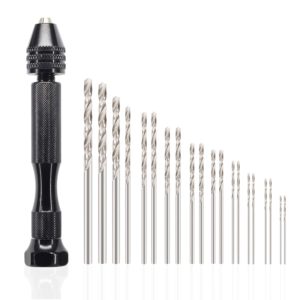
Hand drills are an important tool for boring holes in woodcrafts. In the absence of power, hand drills are especially useful for outdoor projects too. They come in a variety of shapes and types and can be broadly divided into three types; traditional drills, impact drivers and hammer drills.
Pro Tip: keep a variety of drill bits on stock as it’s a pain for construction to cease mid project due to the wrong drill bit.
- Carpenter Square
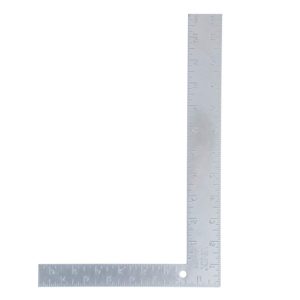 Although it may seem like an ‘old school’ tool that’s been around forever, the use and need for a carpenter’s square still rings true. Simply put, the square is needed to assist with certain cuts. The preferred size is the 6-inch model that is both easy to use and carry. It is also handy when used with a table saw and can assist with some angles as well.
Although it may seem like an ‘old school’ tool that’s been around forever, the use and need for a carpenter’s square still rings true. Simply put, the square is needed to assist with certain cuts. The preferred size is the 6-inch model that is both easy to use and carry. It is also handy when used with a table saw and can assist with some angles as well.
Pro Tip: be sure to choose a metal one as plastic squares can lose their shape which will effect your measurements.
- Chisel
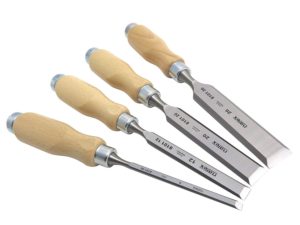 Chisels are used by carpenters and woodworkers to chip wood out of areas that need to be open. A good chisel made of alloyed steel is essentially needed to complete clean cuts. They are available in different sizes starting at ¼ inch to 2 inches long. There are also cornder chisels that will act like a hole punch and will remove a section of wood with just a one hammer blow.
Chisels are used by carpenters and woodworkers to chip wood out of areas that need to be open. A good chisel made of alloyed steel is essentially needed to complete clean cuts. They are available in different sizes starting at ¼ inch to 2 inches long. There are also cornder chisels that will act like a hole punch and will remove a section of wood with just a one hammer blow.
Pro Tip: keep the edges sharp and oiled so the chisel will last as long as possible. Also wood handles are recommended (capped with metal) so they can withstand the constant hammering.
- Clamps
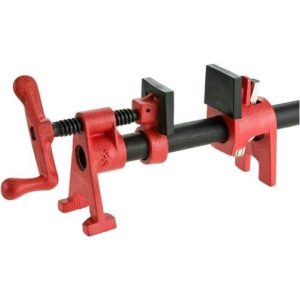 Clamps are used to secure and grip pieces of wood and lumber so your hands can be free to saw, cut or perform other woodworking tasks more efficiently. They come in a variety of sizes models, styles and designs allowing you to attach them to different work surfaces. Clamps are certainly another staple tool used by carpenters.
Clamps are used to secure and grip pieces of wood and lumber so your hands can be free to saw, cut or perform other woodworking tasks more efficiently. They come in a variety of sizes models, styles and designs allowing you to attach them to different work surfaces. Clamps are certainly another staple tool used by carpenters.
Pro Tip: quick clamps are useful to use when making 45 to 90 degree cuts.
- Jig
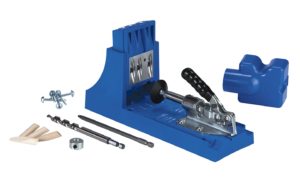 A jig (also known as a pocket hole jig) is a hand tool that allows you to make the same accurate cut repeatedly without having to measure each time. In this respect, if you tend to cut the same size hole over many projects, making a jig will allow you to mark it up to be cut without having to remeasure each time.
A jig (also known as a pocket hole jig) is a hand tool that allows you to make the same accurate cut repeatedly without having to measure each time. In this respect, if you tend to cut the same size hole over many projects, making a jig will allow you to mark it up to be cut without having to remeasure each time.
- Block plane
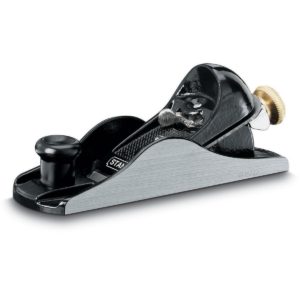
Block planes can flatten, square or add curves to your projects. They are essentially used to smooth out projects that have been dovetailed together.
- Angle Finder
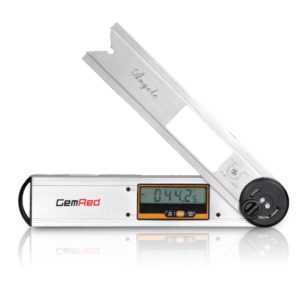 Angle finders come in handy when you want to duplicate an existing angle or use it to set a desired angle by using it with it’s combined measuring features (eg it acts as a ruler, goniometer, framing square and a protractor).
Angle finders come in handy when you want to duplicate an existing angle or use it to set a desired angle by using it with it’s combined measuring features (eg it acts as a ruler, goniometer, framing square and a protractor).
Pro Tip: The digital benefit (over the basic sliding bevel) is the accuracy of laser etched measurements to +0.3 degrees. A great choice for DIY projects and daily use.
- Hand Saw
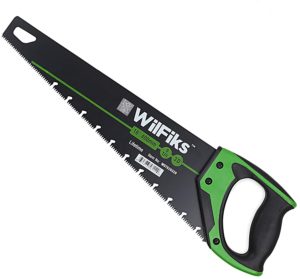 May seem a bit old school, but hand saws come in really handy when you want to feel how the wood responds to the cutting blade (and you really can’t do this with any kind of power saw). Plus they are clearly more portable than a power saw and for the low up front cost, are a worthwhile investment.
May seem a bit old school, but hand saws come in really handy when you want to feel how the wood responds to the cutting blade (and you really can’t do this with any kind of power saw). Plus they are clearly more portable than a power saw and for the low up front cost, are a worthwhile investment.
- Miter Gauge
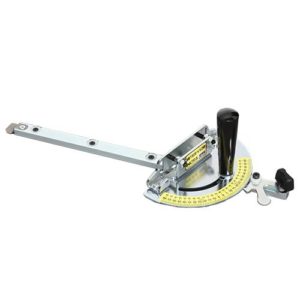 A miter gauge is a tool used for holding pieces at different angles when using saws (like a table saw) or sanded on a stationary disk sander.
A miter gauge is a tool used for holding pieces at different angles when using saws (like a table saw) or sanded on a stationary disk sander.
- Spirit Level
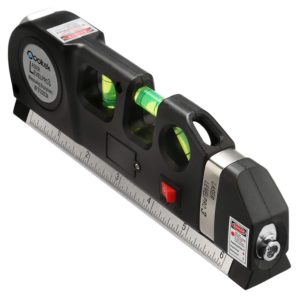 Although you can now get spirit levels on your smart phone, some carpenters prefer having longer levels for a neater end product. A short level might mislead you if you are not familiar with the tolerances and deviations when using this type. Either way, spirit levels are critical to obtaining the perfect levelled surface or product.
Although you can now get spirit levels on your smart phone, some carpenters prefer having longer levels for a neater end product. A short level might mislead you if you are not familiar with the tolerances and deviations when using this type. Either way, spirit levels are critical to obtaining the perfect levelled surface or product.
- Moisture Meter
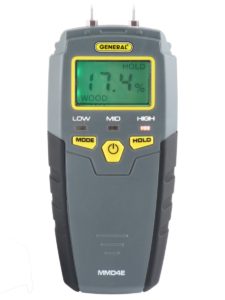 A moisture meter provides a reading of the amount of moisture detected in piece of wood. It should have settings on it for different species of wood since the different woods require different amounts of moisture depending on where they come from in the world.
A moisture meter provides a reading of the amount of moisture detected in piece of wood. It should have settings on it for different species of wood since the different woods require different amounts of moisture depending on where they come from in the world.
- Claw Hammer
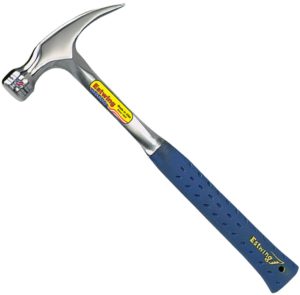 Another must have tool for those in the construction trade is the claw hammer. I personally would recommend a hammer 20 oz with steel handles as it will allow for the right driving force plus great grip when driving nails. For comfort, make sure the hammer has rubberized grip for better control and grip performance.
Another must have tool for those in the construction trade is the claw hammer. I personally would recommend a hammer 20 oz with steel handles as it will allow for the right driving force plus great grip when driving nails. For comfort, make sure the hammer has rubberized grip for better control and grip performance.
Pro Tip: Wood handles are ok too if you are driving a lot of nails, but can make your hand sweaty unless you are wearing safety gloves.
- Push Block
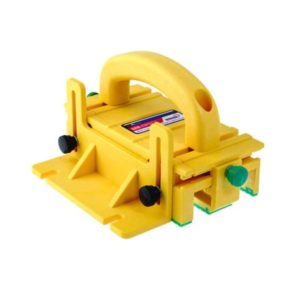 A push block is a safety device used when working with table saws, bandsaws or stationary routers or jointers. It is a useful device that comes in handy to safely maneuver a workpiece by keeping it flat against a machine table or fence while it’s being cut (like a carpenter’s third hand). You don’t want to accidentally get cut by placing your fingers too close to the cutting blade. To prevent this, you just use the push block to push your wood tight to the rip fence while cutting.
A push block is a safety device used when working with table saws, bandsaws or stationary routers or jointers. It is a useful device that comes in handy to safely maneuver a workpiece by keeping it flat against a machine table or fence while it’s being cut (like a carpenter’s third hand). You don’t want to accidentally get cut by placing your fingers too close to the cutting blade. To prevent this, you just use the push block to push your wood tight to the rip fence while cutting.
Pro Tip: I find the push block better than a feather board as they are a lot better at preventing kickback. A genius idea!
- Rip Fence
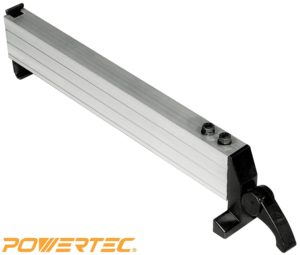 Rip fences are used to guide your wood perfectly straight while you are cutting. You attach them to your table saw so they run parallel to the blade. Rip fences ensure you will get a straight, even cut.
Rip fences are used to guide your wood perfectly straight while you are cutting. You attach them to your table saw so they run parallel to the blade. Rip fences ensure you will get a straight, even cut.
Pro Tip: get one that has fine tuning adjustments for better accuracy.
- A Torque Wrench
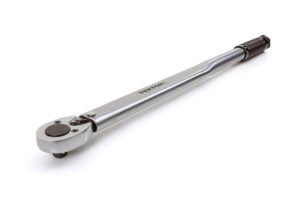 While a torque wrench may seem like a luxury you won’t need, they do come in handy when the tightness of screws and bolts is crucial. Basically it allows the operator to set the torque (force) applied to the fastener so it can be matched to the specifications of the project you’re working on. The torque wrench is different to a regular one as it has an electronic window (or some make a clicking noise) or needle or gauge showing how much force is being applied to it’s handle. Of course it’s advisable to also invest in a good wrench (spanners) as well to assist when turning rotary fasteners, nuts and bolts.
While a torque wrench may seem like a luxury you won’t need, they do come in handy when the tightness of screws and bolts is crucial. Basically it allows the operator to set the torque (force) applied to the fastener so it can be matched to the specifications of the project you’re working on. The torque wrench is different to a regular one as it has an electronic window (or some make a clicking noise) or needle or gauge showing how much force is being applied to it’s handle. Of course it’s advisable to also invest in a good wrench (spanners) as well to assist when turning rotary fasteners, nuts and bolts.
- Router
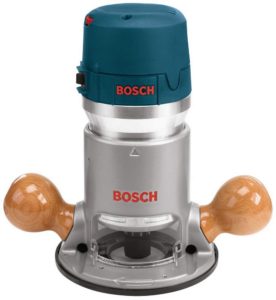 A router is a hand tools (or power tool) that lets you rout (hollow out) a hard area like wood or plastic. They are mainly used in cabinetry and woodworking to shape the edges of your work. They will also let you drop the bit into the middle of a flat surface, cut out your desired shape and let you lift it back up again.
A router is a hand tools (or power tool) that lets you rout (hollow out) a hard area like wood or plastic. They are mainly used in cabinetry and woodworking to shape the edges of your work. They will also let you drop the bit into the middle of a flat surface, cut out your desired shape and let you lift it back up again.
- Calipers
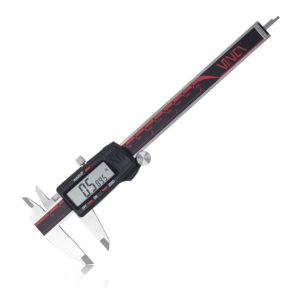 Calipers are a measurement tool used to measure the distance between two opposite sides of an object. They help you to fine tune your woodworking projects.
Calipers are a measurement tool used to measure the distance between two opposite sides of an object. They help you to fine tune your woodworking projects.
Pro Tip: the digital ones are the best as its easy to display inch/metric/fraction conversions with smooth sliding and accurate results.
- Drill Press
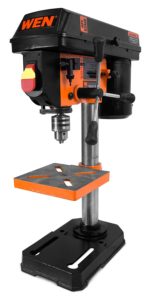 Although a drill press can be used for drilling, it can also be fitted with a mortising attachment and drilling square hole and be used as spindle sander. It can also drill large diameter holes much more efficiently than a hand-held drill.
Although a drill press can be used for drilling, it can also be fitted with a mortising attachment and drilling square hole and be used as spindle sander. It can also drill large diameter holes much more efficiently than a hand-held drill.
- Sandpaper
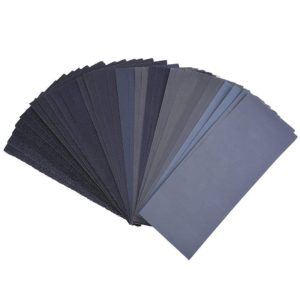 Sandpaper is used to remove material from surfaces to either make them smoother (eg in painting preparation and wood finishing), to remove a surface layer (eg old paint) or sometimes to make a surface rougher (eg preparation for gluing).
Sandpaper is used to remove material from surfaces to either make them smoother (eg in painting preparation and wood finishing), to remove a surface layer (eg old paint) or sometimes to make a surface rougher (eg preparation for gluing).
Pro Tip: get a multi-functional pack with sandpaper you can use for craft, woodwork, automotive, metal and applications for buffing and polishing.
- Sturdy Workbench
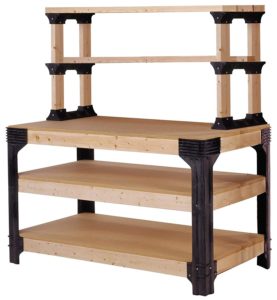 One of the most versatile ‘tools’ in a workshop is the workbench. It is the foundation that supports all sorts of jobs and as such should be sturdy and reasonable in size. Some just try and work with a table saw, but I find the saw just gets in the way and it is simply not big enough.
One of the most versatile ‘tools’ in a workshop is the workbench. It is the foundation that supports all sorts of jobs and as such should be sturdy and reasonable in size. Some just try and work with a table saw, but I find the saw just gets in the way and it is simply not big enough.
Pro Tip: when organising your workspace, begin with measuring out one that will fit your needs as you don’t want to cram one in as an afterthought down the track. And if you are limited on space, perhaps consider one with shelving included.
- Sawhorse
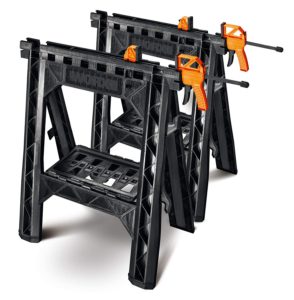 A saw horse allows you to rest pieces of wood while you work or cut other areas to it. They are light weight and portable and used frequently by carpenters helping them to make precise cuts. Some models are even equipped with clamps and adjustable surfaces so you can move it around to fit almost any type of wood. They are particularly handy for extra-large projects. I love my saw horse!
A saw horse allows you to rest pieces of wood while you work or cut other areas to it. They are light weight and portable and used frequently by carpenters helping them to make precise cuts. Some models are even equipped with clamps and adjustable surfaces so you can move it around to fit almost any type of wood. They are particularly handy for extra-large projects. I love my saw horse!
- Cordless Drill
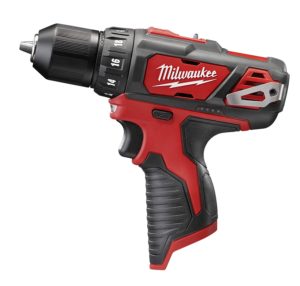
Cordless drills are one of those must have tools for the professional and DIYer alike. Whether you need to drill multiple holes or drive a fastener, a good one will let you accomplish a lot – from basic maintenance to building a house, you will need a drill. The cordless ones are convenient and allow you to both drill and fasten more so than their corded counterparts.
Pro Tip: to save money, consider buying a drill as part of a kit which includes battery and a charger plus other drill accessories.
- Palm Sander
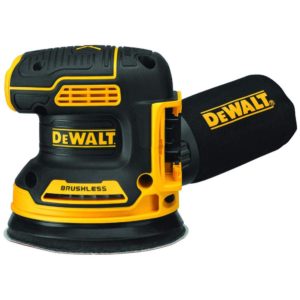
Palm sanders reflect their name sake; a sander that can fit in the palm of your hand. This allows them to be small enough to get into almost any space you have. For spaces smaller than what they allow, you will still need to use plain old sandpaper, but by and large a palm sander is a great little finisher to get jobs done. Another bonus is that they only use ¼ of a sheet of sandpaper so are really efficient.
- Table Saw
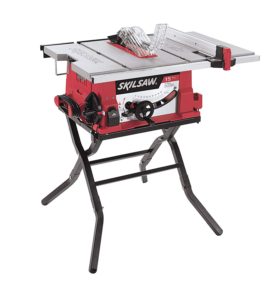 It’s amazing the amount of applications a table saw can do. They are used to rip, miter, shape, square, groove and join your projects. I use mine a lot. The downside is that they’re not cheap but if you’re going to use it a lot, it is better to invest in a quality one that will last.
It’s amazing the amount of applications a table saw can do. They are used to rip, miter, shape, square, groove and join your projects. I use mine a lot. The downside is that they’re not cheap but if you’re going to use it a lot, it is better to invest in a quality one that will last.
- Shop Vac
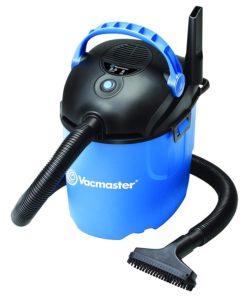 As you’re aware, any form of woodwork creates a large amount of sawdust and even little chunks of wood left behind from cutting and shaping. A shop vac helps you to clean up the mess. It has a diameter hose with varying attachments combined with a bucket to hold larger quantities than a normal vacuum. Tip; you can connect your shop vac to your table saw and turn it on while you cut. This will suck up the sawdust before it ever hits the floor.
As you’re aware, any form of woodwork creates a large amount of sawdust and even little chunks of wood left behind from cutting and shaping. A shop vac helps you to clean up the mess. It has a diameter hose with varying attachments combined with a bucket to hold larger quantities than a normal vacuum. Tip; you can connect your shop vac to your table saw and turn it on while you cut. This will suck up the sawdust before it ever hits the floor.
Final Thoughts……..
Of course there are a multitude of other tools used regularly by carpenters and those into DIY. The ones listed above are some of the more common and popular choices due to the regularity of use.
There are also a lot of power tools to consider – particularly cutting tools like miter saws, circular saws and reciprocating saws, with these tools dependent on the types of jobs you intend to do. The first step is to assess how much you want to spend and how much use you’ll get out of each one to ensure you make a smart investment.
As always we encourage you to read a lot of reviews and consider the features and benefits of each tool on offer and to ensure you have the right warranty in place in case you need to return it.
